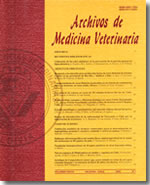Standardization of two Polymerase Chain Reaction tests for the diagnosis of Salmonella enterica subspecie enterica in eggs
Main Article Content
Abstract
Salmonella enterica subspecie enterica is an important cause of zoonoses due to its capacity of infecting animals and humans. Poultry and its derivates are sources of transmission, therefore detection becomes an important control measure. Microbiological cultures are currently being used for this purpose but they have sensitivity limitations; molecular alternatives such as PCR allow for a fast and specific detection of Salmonella. The objective of this study was to standardize a PCR for Salmonella in egg samples and a multiplex PCR for Enteritidis and Typhimurium. One hundred and fourty four egg samples were studied: 36 shell wash, 36 yolk-albumen, 36 peptone water plus yolk-albumen, and 36 washes of internal shell. In addition, 24 yolk-albumen samples were infected with 4 different Salmonella serotypes. The DNA from the samples was tested for hilA and multiplex PCR. The PCR for hilA gene showed a sensitivity (S) of 70.83% and specificity (Sp) of 100%, a positive predictor value (PPV) of 100%, and a negative predictive value (NPV) of 96.3%. The multiplex PCR showed a S of 75% and a Sp of 98.4%, PPV of 75%, and NPV of 98.4%. Both PCR tests can detect 0.27 µg/ml of DNA. The results show a potential value of these tests for the detection and control of salmonellosis transmitted by eggs. Further studies are needed in order to improve the sensitivity of detection, so that both tests can be used in the poultry and food industry.

